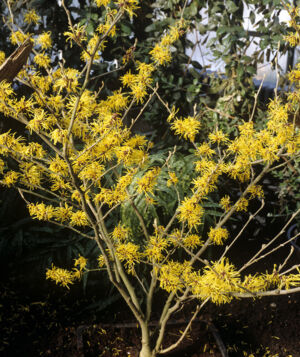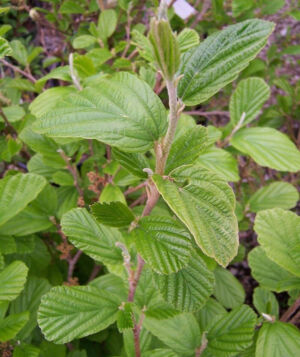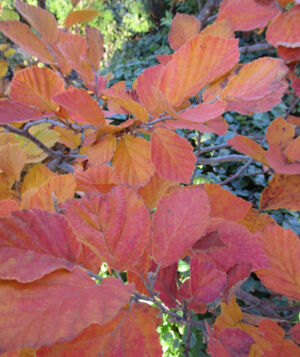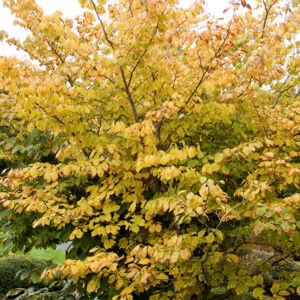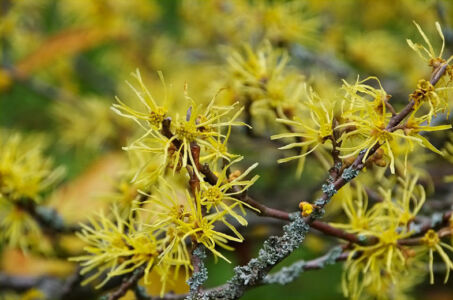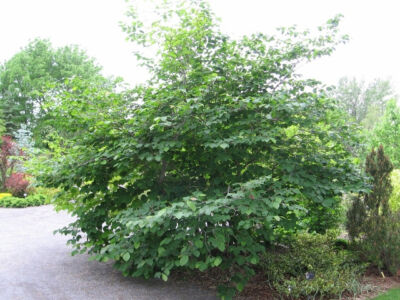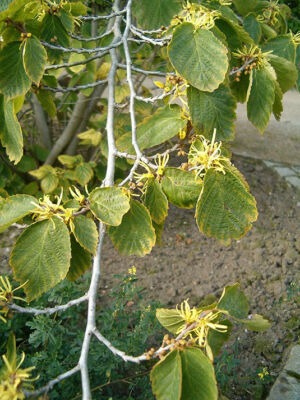Hamamelis vernalis- Vernal Witchhazel
Description
General: A dense rounded shrub that varies in form. Branches are low and bend upward to form a broad, rounded outline. Suckers to form large colonies. Grows 6-10’ high with a greater spread.
Leaves: Alternate, simple and obovate, 2-5” long. New growth is bronze to red purple, maturing to dark green in the summer and changing to golden yellow in the fall.
Flowers: Vary from yellow to red and about 1” across. Each flower has roughly 4 petals that are each ½” long. Usually, the inner surface is red and the petals are yellow, but some plants are a solid orange, yellow, or red. Flowers are very fragrant and persist from January through March
Fruit: Green-yellow to brown capsule holding black seeds. September to October.
Attributes: A hardy and durable shrub that’s great for screens and hedges, especially with its yellow fall color. Extraordinary and unique with its winter bloom date and unusual flowers.
Culture
Hardiness: Zones 4-8.
Growing Conditions: Prefers wet areas or poorly drained clay soils. Does well in full sun or part shade and is PH adaptable.
Maintenance: No serious insect or disease issues and rarely requires pruning.
Transplanting: No issues to speak of. Root pruning during the transplanting process aids in root development. Keep specimen moist.
Our Experience
Experience at Great Hill
Our witchhazels bring a welcome pop of light, fragrance and color to an otherwise drab winter landscape. They are a great shrub to utilize in a wet woodland area. Beneficial to look for a cultivar who drops its leaves before flowering starts.
Hamamelis virginiana- Common Witchhazel
Description
General: A small tree or large shrub with large crooked spreading branches that form an irregular, rounded, spreading crown. Grows 20-30’ with similar spread.
Leaves: Alternate and simple 3-6” long, obovate. Medium green color in the summer changing to a brilliant yellow in the fall.
Flowers: Bright yellow fragrant flowers each with 4 crinkly ribbon shaped petals ½ to 2/3” long. Flowers hug shrub stems and bloom from October through December either after leaf drop or during fall coloring of the leaves.
Fruit: Greenish seed capsules ½” long that become woody with age and mature to a light brown.
Attributes: Useful for shrub borders, woodland gardens, and naturalized areas as screens or tall hedges.
Culture
Hardiness: Zones 3-9.
Growing Conditions: Prefers moist soil and full sun to part shade. Is PH adaptable and pollution tolerant.
Maintenance: No serious insect or disease issues. Does not require pruning.
Transplanting: Transplants well, benefits from root pruning to induce regrowth and requires moist soil upon planting.
Our Experience
Experience at Great Hill
Hamamelis virginiana is perfect for naturalized areas and shrub borders and is especially showy during the fall months. We have a couple specimens in our nursery that have been maintenance free, display beautiful fall color and flower yearly. To maintain a tidy habit, plant in full sun. The extract witchhazel is distilled from the bark of young stems and roots and is useful as an anti-inflammatory.
Hamamelis Bloom Data 2022
| Plant Name | Bud Break | Full Bloom | Bloom Drop |
|---|---|---|---|
| vernalis | January 5 | March 10 | April 15 |
| virginiana | October 14 | November 3 | December 27 |

